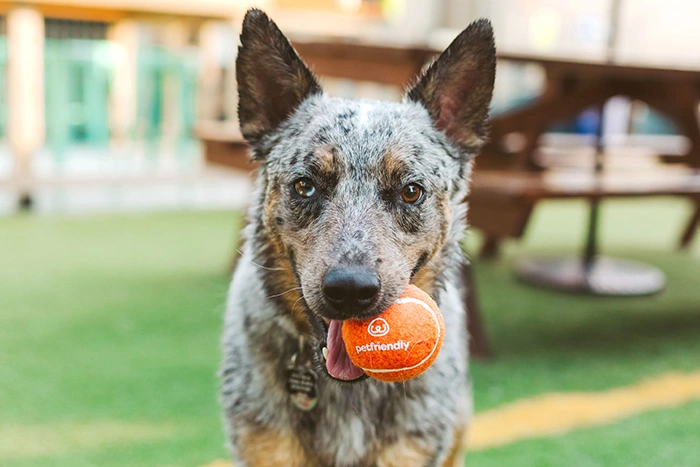The best dog food for each life stage is formulated to meet your dog’s specific nutritional needs: high-calorie, DHA-rich food for puppies, balanced maintenance formulas for adults, and lower-calorie, joint-supporting diets for seniors.
Choosing the right food prevents health issues and extends your dog’s life. Below, we’ll break down exactly what to feed your dog from puppyhood through their golden years.
Why Life Stage Nutrition Matters
Feeding your dog the same food throughout their entire life is like feeding a toddler, a teenager, and a retiree identical meals.
Their bodies are doing vastly different things at each phase, and the nutrients they need shift dramatically.
Puppies are building muscle, bone, and brain tissue at an astonishing rate. Adult dogs need fuel for maintenance and activity. Seniors require support for aging joints and slower metabolism.
The Association of American Feed Control Officials (AAFCO) sets specific nutrient profiles for growth, maintenance, and all life stages.
Foods that meet these standards are tested to ensure they contain the right balance of protein, fat, vitamins, and minerals for that specific phase.
Feeding a generic “all life stages” food often means compromising—it might be adequate for everyone, but optimal for no one.
Life-stage-specific nutrition helps prevent developmental issues in puppies, maintains lean muscle mass in adults, and can add healthy, active years to a senior dog’s life.

Best Dog Food for Each Life Stage
Puppies (8 weeks to 12 months): Building Blocks for Life
Puppies grow incredibly fast, sometimes reaching 50 times their birth weight in their first year. This explosive development demands a diet rich in calories and specific nutrients that adult dog food simply doesn’t provide enough of.
Nutritional Priorities:
- Protein (22-32%): Look for high-quality animal proteins like chicken, lamb, or fish as the first ingredient. Protein provides the amino acids necessary for muscle and tissue development.
- Fat (8-20%): Fat supplies concentrated energy for play and growth. It also makes food taste great, which helps picky puppies eat consistently.
- DHA (Docosahexaenoic Acid): This omega-3 fatty acid, found in fish oil, is critical for brain and vision development. Studies show puppies fed DHA-enhanced diets have improved trainability.
- Calcium & Phosphorus: The balance of these minerals (typically a 1.2:1 ratio) is crucial for proper bone development, especially in large breeds. Too much or too little can cause lifelong skeletal problems.
What to Look For on the Label:
Choose foods with an AAFCO statement saying the food is “complete and balanced for growth and reproduction” or “for all life stages, including growth of large-size dogs (70 lbs or more as an adult).”
The latter is vital for large breeds, as it ensures controlled growth to prevent developmental orthopedic diseases.
Feeding Schedule & Amount:
Puppies under 6 months should eat three times daily. From 6-12 months, you can transition to twice daily.
Use the feeding guide on the bag as a starting point, but monitor your puppy’s body condition. You should be able to feel their ribs easily without seeing them.
Common Puppy Feeding Problems Solved:
- Loose Stools: Often caused by overfeeding or too-rapid diet changes. Ensure you’re feeding the correct amount and transitioning foods over 7-10 days.
- Picky Eating: Puppies can be finicky. Warming the food slightly or adding a splash of warm water releases aromas that stimulate appetite. A puzzle feeder bowl can also make mealtime engaging and slow down fast eaters, improving digestion.

Adult Dogs (1-7 years): Maintaining Peak Health
Once your dog reaches adulthood, their nutritional needs shift from building to maintaining. The goal is to preserve lean muscle mass, support daily energy needs, and prevent obesity.
Nutritional Priorities:
- Protein (18-25%): Still critical, but slightly lower than puppy food. The focus is on maintenance, not rapid growth. Quality protein sources help dogs feel full and maintain muscle.
- Fat (10-15%): Provides energy but must be balanced to avoid weight gain. Active dogs need higher fat; less active dogs need moderate fat.
- Fiber: Moderate fiber (3-5%) aids digestion and helps dogs feel satiated. Ingredients like beet pulp or brown rice are common sources.
Activity Level Adjustments:
A Border Collie that herds daily needs more calories and fat than a Pug that naps on the couch. “Active lifestyle” formulas contain more protein and fat. For lower-energy dogs, look for “healthy weight” or “weight management” formulas with fewer calories per cup and added L-carnitine to help burn fat.
Grains vs. Grain-Free: What’s the Evidence?
Grain-free diets became popular, but the FDA is investigating a potential link between grain-free foods and dilated cardiomyopathy (DCM) in dogs. Unless your dog has a diagnosed grain allergy (which is rare), grain-inclusive foods with wholesome grains like oats, barley, or rice are nutritious and safe. The key is whole grains, not fillers like corn gluten meal.
Feeding Guidelines:
Most adult dogs do well with two meals per day. Measure food precisely with a standard measuring cup. Free-feeding (leaving food out) often leads to obesity. The average 50-pound adult dog needs about 1,000 calories daily, but this varies significantly by breed and activity.

Senior Dogs (7+ years): Supporting Golden Years
Aging brings changes in metabolism, joint health, and organ function. Senior dog foods are designed to address these specific challenges.
Nutritional Priorities:
- Lower Calories (10-20% fewer than adult food): Metabolism slows, and activity decreases. Fewer calories prevent obesity, which worsens joint problems.
- Higher Quality Protein: Contrary to old myths, seniors need more easily digestible protein (25-30%) to prevent muscle wasting. Look for named meat meals (e.g., “chicken meal”), which are concentrated protein sources.
- Joint Support: Look for added glucosamine and chondroitin sulfate (300-500 mg/100g) to support cartilage health. Omega-3 fatty acids (EPA/DHA) from fish oil reduce joint inflammation.
- Enhanced Fiber: (5-8%) Helps with digestion, which can slow with age. It also aids in weight management.
- Antioxidants: Vitamin E, vitamin C, and beta-carotene support cognitive function and immune health.
When to Switch to Senior Food:
There’s no single age. Small breeds (under 20 lbs) may not need senior food until 9-10 years old. Giant breeds (over 90 lbs) can benefit from senior formulas as early as 5-6 years. Watch for signs like decreased activity, weight gain, or stiffness.
Senior-Specific Problems & Solutions:
- Decreased Appetite: Warm food to enhance smell. Choose smaller kibble if dental issues are present. Canned food toppers can increase palatability.
- Dental Issues: Softer kibble or adding warm water can make chewing easier. Regular dental chews and veterinary cleanings remain important.
- Kidney Health: If your vet detects early kidney disease, they may recommend a senior diet with controlled phosphorus and moderate protein. Always follow veterinary advice for medical conditions.
Key Factors That Change the Equation
Breed Size Matters
Small Breeds (under 20 lbs): They have faster metabolisms and burn calories quickly. Look for calorie-dense, small-sized kibble to prevent hypoglycemia and choking. Small breed formulas also often have added taurine for heart health.
Large & Giant Breeds (over 70 lbs): These dogs are prone to hip dysplasia and bloat. Large-breed puppy formulas are essential to control growth speed. For adults, foods with added taurine and L-carnitine support heart health. Elevated feeders and slow-feeder bowls can reduce bloat risk during meals.
Special Health Considerations
Food Allergies & Sensitivities: True food allergies (immune response) are less common than sensitivities (digestive upset). Common triggers are beef, dairy, chicken, and wheat. Limited-ingredient diets with novel proteins (duck, venison, kangaroo) can help identify triggers. Always work with your vet.
Weight Management: Over 56% of dogs in the U.S. are overweight or obese. Excess weight reduces lifespan by up to 2.5 years. Weight management foods use high fiber and low fat to reduce calories while keeping dogs full. Measuring portions and eliminating treats is crucial.
Digestive Sensitivities: For dogs with chronic soft stools or gas, look for foods with prebiotics (like chicory root) and probiotics (live beneficial bacteria). Easily digestible carbohydrates like rice or sweet potato are gentler than corn or wheat.
Critical Nutrients: A Plain-English Breakdown
Understanding the label is key to choosing the best dog food for each life stage.
- Protein: From meat, fish, or eggs. Avoid foods where “meat by-products” are the first ingredient. Named meats (e.g., “deboned chicken”) are higher quality.
- Fats: Chicken fat and fish oil are excellent sources. They provide energy and essential fatty acids for skin and coat health.
- Carbohydrates: Oats, brown rice, barley, and sweet potato provide energy and fiber. Avoid foods where vague “cereals” appear high on the list.
- Vitamins & Minerals: A “complete and balanced” statement ensures these are included. Chelated minerals (e.g., “zinc proteinate”) are more easily absorbed.
- Avoid: Artificial colors, flavors, and preservatives like BHA, BHT, and ethoxyquin. Natural preservatives like mixed tocopherols (vitamin E) are safer.
Common Mistakes That Harm Your Dog
- Switching Foods Too Quickly: This causes digestive upset. Always transition gradually over 7-10 days, mixing increasing amounts of the new food with the old.
- Following the Bag’s Feeding Guide Blindly: These are guidelines, not rules. Adjust based on your dog’s body condition. If they’re gaining weight, feed 10% less.
- Falling for Marketing Hype: “Human-grade,” “natural,” and “premium” have no legal definitions. Focus on AAFCO statements and ingredient quality, not buzzwords.
- Ignoring Dental Health: Kibble alone doesn’t clean teeth. Combine good food with dental chews and regular brushing.
- Overfeeding Treats: Treats should never exceed 10% of daily calories. Most are calorie-dense and nutritionally unbalanced.
- Skipping Vet Check-ins: Annual exams catch weight changes and health issues early, allowing diet adjustments before problems become serious.
- Feeding Table Scraps: Human food is often too fatty, salty, or toxic (onions, grapes, chocolate). It also creates picky eaters.
How to Transition Dog Foods Safely
Changing your dog’s diet requires patience. A sudden switch can cause vomiting, diarrhea, and loss of appetite. Follow this 10-day plan:
- Days 1-3: Mix 25% new food with 75% old food.
- Days 4-6: Mix 50% new food with 50% old food.
- Days 7-9: Mix 75% new food with 25% old food.
- Day 10: Feed 100% new food.
If your dog shows any signs of digestive distress, slow down the transition. For dogs with sensitive stomachs, extend each phase to 3-4 days. Always ensure fresh water is available.
Frequently Asked Questions
Can I Feed Adult Dog Food to a Puppy?
No. Adult food lacks the calorie density and specific nutrients (like DHA and proper calcium levels) puppies need for proper development. This can lead to stunted growth or skeletal abnormalities. Puppy formula is essential for the first year (or longer for large breeds).
How Do I Know If a Food Is Working for My Dog?
Look for these positive signs within 4-6 weeks: small, firm stools; shiny coat; clear eyes; good energy levels; healthy body weight. Negative signs include chronic diarrhea, excessive gas, vomiting, dull coat, itching, or lethargy. If you see these, consult your vet and consider a diet change.
Is Expensive Dog Food Always Better?
Not necessarily. Price doesn’t guarantee quality. Some expensive brands invest heavily in marketing rather than research. Focus on companies with board-certified veterinary nutritionists on staff, feeding trials (not just formulation), and transparent sourcing. Mid-range brands with strong science can outperform pricey boutique brands.
Should I Choose Grain-Free Food?
Only if your veterinarian recommends it for a diagnosed grain allergy. For most dogs, grains are nutritious and digestible. The potential link between grain-free diets and heart disease (DCM) is still being studied. Grain-inclusive foods with whole grains are the safer default choice.
When Exactly Should I Switch to Senior Food?
Transition when you notice age-related changes, not just a birthday. For small breeds, around 9-10 years; medium breeds, 7-8 years; large breeds, 6-7 years; giant breeds, 5-6 years. Your vet’s advice based on physical exam findings trumps any calendar date.
Final Thoughts: Your Dog’s Nutritional Journey
Choosing the best dog food for each life stage is one of the most impactful decisions you’ll make for your pet’s long-term health. Puppyhood sets the foundation, adulthood maintains the fortress, and the senior years should be comfortable and active.
By understanding the specific protein, fat, and calorie needs for each phase—and by watching your individual dog’s body condition, energy, and health—you can make informed choices that add years to their life and life to their years.
Measure every meal, transition foods gradually, and partner with your veterinarian. Don’t chase trends; chase science-backed nutrition that matches your dog’s current life stage and lifestyle.






